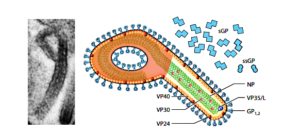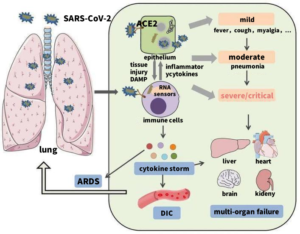Abstract: Cytokines are small molecule soluble proteins secreted by cells and involved in preventing serious diseases like cancer. They promote the formation and development of specific organs, help to maintain homeostasis and also improve the body defense function against pathogen invasion. Cytokine storm(also called hypercytokinemia) is a serious immune overreaction. The self-overprotected effects of cytokine storm is uncontrollable and more dangerous than primary diseases. Medical staff should efficiently manage and diminish the effects.
Keywords: Cytokine Storm Treatment, High Levels of Cytokines, Causes of Cytokine Storm, Immunity, Inflammation
1. High Levels of Cytokines
In normal situation, immune system can quickly recognize and remove invasive pathogen, monitor and eliminate abnormal cells in vivo(e.g. tumor cells). However, regular defense mechanism of immune system may not fight against serious virus infection or some drug reactions. Then, the immune system will try to rapidly and extensively secrete cytokines to control. The purpose aims to improve immune response to fight against invaders. However, high levels of cytokines greatly damage the human body. These excessive signaling molecules can cause continuous high fever and multiple organ dysfunction by triggering the positive feedback loop of inflammation and attacking normal tissues.

2. Causes of Cytokine Storm
2.1. CAR-T Cytokine Storm
CAR-T cell therapy is an innovative cancer therapeutics. This therapy reconstructs genes to express a specific chimeric antigen receptor(CAR) by collecting patients’ T cells. The receptor can recognize the specific antigen on the surface of cancer cells. The reinfusion of reconstructed gene to patients’ body can more recognize and kill cancer cells. Currently, CAR-T therapy has the obvious effects on the treatment of leukemia and lymphoma. However, outstanding problems include high cost, the risk of target-missing and T cell depletion. Symptoms of cytokine storm are high fever, hypotension, multiple organ failure and accelerated death etc.
2.2. Ebola Cytokine Storm
Ebola virus is known with the fatality rate of 90% and phobia symptoms. The virus inhibits antigen presenting ability and escapes from the recognition of immune system. The rapid reproduction damages host cells. Then, overreaction of immune system causes cytokine storm and release of a large number of proinflammatory cytokines(e.g. IL-1, IL-6) to further damage normal tissues. Nitric oxide and tumor necrosis factor released by macrophage increase liver injury and vascular coagulation disorder. Neutrophils promote vascular leakage and cause internal hemorrhage. Finally, multiple organ failure, high fever and subcutaneous hemorrhage expedite patients' death. The immune system is self-destructed in the struggle against the virus.

2.3. Cytokine Storm in COVID-19
The COVID-19 coronavirus enter in vivo cells via ACE2, and high expression of ACE2 in lung tissue increases the rapid proliferation. The coronavirus damages pulmonary cells and results in strong reaction of immune system. A large number of immunocytes and tissue fluid accumulate in the lung. The blocking of gas exchange causes dyspnea. Non-specific cytokine storm attacks virus and causes white lung by damaging normal lung cells. Persistent inflammatory response increases alveolar vascular permeability, leading to further lung injury like pulmonary edema and lung fibrosis. The lack of spontaneous breath decreases blood oxygen. Accumulation of carbon dioxide induces toxic reaction in blood and renal failure. Besides, the coronavirus may infect other organs expressing ACE2 and threaten patients’ life via multiple organ failure.

3. Cytokine Storm Treatment
There are two types of cytokine storm treatment. Maintenance of blood volume and nutrition can decrease body damage by infusion. Using drugs like interleukin blockers(e.g. Siltuximab) to inhibit activated immune cells and production of cytokines. Immunosuppressants like glucocorticoid and cyclosporin A are clinically used for regulating immune response. However, these drugs can decrease immunity and should pay close attention to patients’ status. Symptoms of cytokine storm are non-specific and more common in critical patients. Misdiagnosis and delay treatment often happen. Thus, further research on more effective therapeutics is required.
Surveillance of cytokine level is more important. Timely detection and surveillance of concentration of various cytokines(e.g. IL-6, TNF-α) can help physicians recognize the generation of cytokine storm and take intervention measures in the early phase.
4. Recommended Products
4.1. Recombinant Proteins
|
Cat.No |
Product Name |
Mol. wt. |
Host |
|
Recombinant Chicken IL-1b |
19.9 kDa |
E.Coli |
|
|
Recombinant Guinea Pig IL-1b |
19.1 kDa |
E.Coli |
|
|
Recombinant Human IL-6 |
20 kDa |
E.Coli |
|
|
Recombinant Human IL-10 |
19.2 kDa |
E.Coli |
|
|
Recombinant Hamster TNFA |
29.3 kDa |
E.Coli |
|
|
Recombinant Human IL-8 |
8.3 kDa |
E.Coli |
|
|
Recombinant Human VEGFA |
15.9 kDa |
E.Coli |
|
|
Recombinant Human TGFB1 |
16,38,55 kDa |
HEK293 cells |
4.2. Antibodies
|
Cat.No |
Product Name |
Applications |
Antibody Type |
|
IL6 antibody |
ELISA, WB, IHC, IF |
Rabbit pAb |
|
|
IL10 antibody |
ELISA, WB, IHC |
Rabbit pAb |
|
|
VEGFA antibody |
ELISA, IHC, IF, WB |
Rabbit pAb |
4.3. ELISA Kits
|
Cat.No |
Product Name |
Range |
Sensitivity |
|
Human IL-1 β QuickTest ELISA Kit |
3.906-250pg/ml |
2.344pg/ml |
|
|
Mouse IL-1β QuickTest ELISA Kit |
31.25-200pg/ml |
1.875pg/ml |
|
|
Rat IL-1β QuickTest ELISA Kit |
31.25-2000pg/ml |
18.75pg/ml |
|
|
Human IL-6 QuickTest ELISA Kit |
0.46-30pg/ml |
0.28pg/ml |
|
|
Mouse IL-6 QuickTest ELISA Kit |
1.563-100pg/ml |
0.938pg/ml |
|
|
Human IL-8 QuickTest ELISA Kit |
7.813-500pg/ml |
4.688pg/ml |
|
|
Rat IL-10 QuickTest ELISA Kit |
3.125-200pg/ml |
1.875pg/ml |
|
|
Human VEGF QuickTest ELISA Kit |
31.25-2000pg/ml |
18.75pg/ml |
|
|
Mouse VEGF QuickTest ELISA Kit |
15.625-1000pg/ml |
9.375pg/ml |
|
|
Rat VEGF QuickTest ELISA Kit |
31.25-2000pg/ml |
18.75pg/ml |
|
|
Human TNF-α QuickTest ELISA Kit |
15.625-1000pg/ml |
9.375pg/ml |
|
|
Mouse TNF-α QuickTest ELISA Kit |
3.906-250pg/ml |
2.344pg/ml |
|
|
Rat TNF-α QuickTest ELISA Kit |
3.906-250pg/ml |
2.344pg/ml |
|
|
Human TGF-β1 QuickTest ELISA Kit |
31.25-2000pg/ml |
18.75pg/ml |
|
|
Mouse TGF-β1 QuickTest ELISA Kit |
31.25-2000pg/ml |
18.75pg/ml |
|
|
Rat TGF-β1 QuickTest ELISA Kit |
31.25-2000pg/ml |
18.75pg/ml |
|
|
Human IFN-β QuickTest ELISA Kit |
62.5-4000pg/ml |
37.5pg/ml |
|
|
Human IFNα2 QuickTest ELISA Kit |
15.625-1000pg/ml |
9.375pg/ml |
|
|
Rat IL-6 ELISA Kit |
62.5-4000pg/ml |
37.5pg/ml |
|
|
Human IL-10 ELISA Kit |
7.813-500pg/ml |
4.688pg/ml |
|
|
Mouse IL-10 ELISA Kit |
15.625-1000pg/ml |
9.375pg/ml |
|
|
Mouse IFN-α ELISA Kit |
15.625-1000pg/ml |
9.375pg/ml |
|
|
Rat IFN-α ELISA Kit |
15.625-1000pg/ml |
9.375pg/ml |
|
|
Mouse IFN-β ELISA Kit |
15.625-1000pg/ml |
9.375pg/ml |
|
|
Rat IFN-β ELISA Kit |
15.625-1000pg/ml |
9.375pg/ml |
REFERENCES
[1]Neutrophil-macrophage communication via extracellular vesicle transfer promotes itaconate accumulation and ameliorates cytokine storm syndrome, PMID: 38745069.
[2]Cytokine Storm-Induced Thyroid Dysfunction in COVID-19: Insights into Pathogenesis and Therapeutic Approaches, PMID: 39319193.
